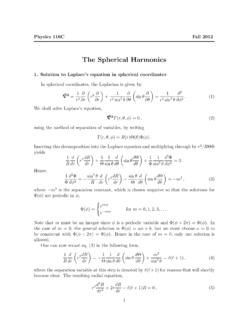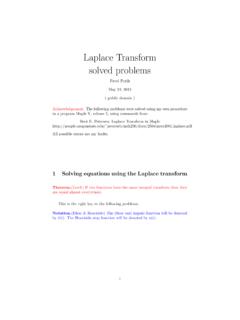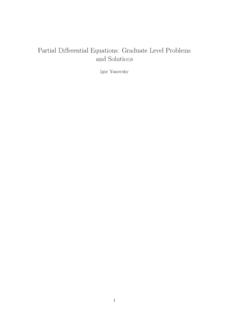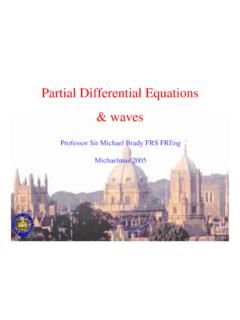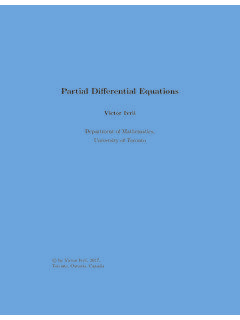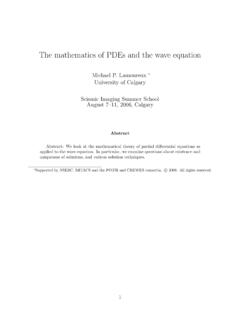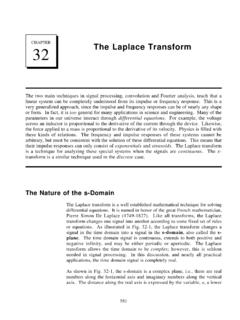Transcription of Laplace transform Solved Problems 1 - Semnan University
1 Solved Problems ON. Laplace transform . Dr. Samir Al-Amer November 2006. Laplace transform . Many mathematical Problems are Solved using transformations. The idea is to transform the problem into another problem that is easier to solve. Once a solution is obtained, the inverse transform is used to obtain the solution to the original problem. The Laplace transform is an important tool that makes solution of linear constant coefficient differential equations much easier. The Laplace transform transforms the differential equations into algebraic equations which are easier to manipulate and solve. Once the solution is obtained in the Laplace transform domain is obtained, the inverse transform is used to obtain the solution to the differential equation. Laplace transform is an essential tool for the study of linear time-invariant systems. In this handout a collection of Solved examples and exercises are provided.
2 They are grouped into two parts: background material and Laplace transform . The background material is supposed to be covered in the prerequisite materials namely MATH 001, MATH002, MATH 101,MATH 102, MATH 201. and MATH 260. Most of the Problems in this part are easy. They are listed here for quick review and to ensure that students can perfectly solve these Problems . The second part is directly related to the material covered in this course. Read the text book for more details. The intension here is not to replace the textbook but rather to give supplementary material to improve the student understanding. LEARNING OBJECTIVES. A list of learning objectives that students are expected acquire in the course is listed below. This problem set is not covering all of them. Read the textbook and make sure that you know all the items below. 1. To define (mathematically) the unit step and unit impulse.
3 2. To express some simple functions in terms of unit step and/or unit impulse 3. To state and use the sampling property of the impulse. 4. To determine if a function is of exponential order or not. 5. To know basic integration rules (including integration by parts). 6. To be able to factor second order polynomials 7. To perform algebraic manipulation of complex numbers. 8. To state the definition of Laplace transform . 9. To give sufficient conditions for existence of Laplace transform . 10. To obtain Laplace transform of simple functions (step, impulse, ramp, pulse, sin, cos, 7 ). 11. To obtain Laplace transform of functions expressed in graphical form. 12. To know the linear property of Laplace transform . 13. To know Laplace transform of integral and derivatives (first and high orders derivatives. 14. To obtain inverse Laplace transform of simple function using the Table of Laplace transform pairs.)
4 15. To use the method of partial fraction expansion to express strictly proper functions as the sum of simple factors (for the cases: simple poles, complex poles and repeated poles). 16. To perform long division and know the reason for using it in inverse Laplace transform . 17. To obtain inverse Laplace transform . 18. To solve constant coefficient linear ordinary differential equations using Laplace transform . 19. To derive the Laplace transform of time-delayed functions. 20. To know initial-value theorem and how it can be used. 21. To know final-value theorem and the condition under which it can be used. BACKGROUND MATERIAL. Topics: 1. Factoring a Second Order Polynomial 2. Integration 3. Limits 4. Complex Number Manipulation 5. Long division 6. Useful identities 1. FACTORING A SECOND ORDER POLYNOMIAL. Factoring of polynomials are needed in solving Problems related to Laplace transform .
5 Factoring high order polynomials may not be easy and computers may be needed to do the factorization. Factoring second order polynomials can be done manually. EXAMPLE 1: Factor the second order polynomial P ( x) = x + 5 x + 6. 2. Answer: This is a simple problem. Find two numbers such that their product is six and their sum is five. They are two and three. P ( x) = x 2 + 5 x + 6 = ( x + 2)( x + 3). EXAMPLE 2: Factor the second order polynomial P ( x) = x 2 + x Answer: It is not easy to guess two numbers such that their product is and their sum is . We can use the formula to find the roots then write the factors. b b 2 4(a )(c). roots of ax 2 + bx + c = 0 are 2( a ). 2 4(1)( ). roots of x 2 + x = 0 are = and 2(1). P ( x) = x 2 + x = ( x + )( x ). EXAMPLE 3: Factor the second order polynomial P ( x) = x 2 + 4 x + 13. Answer: We can use the formula to find the roots then write the factors.
6 4 4 2 4(1)(13). roots of x + 4 x + 13 = 0 are 2. = 2 j 3. 2(1). P ( x) = x 2 + 4 x + 13 = ( x + 2 + j 3)( x + 2 j 3). EXAMPLE 4: Express the second order polynomial P ( x) = x 2 + 4 x + 13 in the sum of square form Answer: 4 4 . 2 2. 4 4 . 2 2. P ( s ) = x 2 + 4 x + 13 = x 2 + 4 x + + 13 = x + + 13 = ( x + 2 ) + (3). 2 2. 2 2 2 2 . EXAMPLE 5: Factor the second order polynomial P ( x) = 2 x 2 + 4 x 6. Answer: ( ). P ( x) = 2 x 2 + 4 x 6 = 2 x 2 + 2 x 3 = 2( x + 3)( x 1). EXAMPLE 6: Factor the second order polynomial P ( x) = ( x + 2) 2 + 16. Answer: This polynomial is expressed as the sum of squares. It has two complex poles. The real part of the roots is -2 and imaginary parts are 4 . P ( x) = ( x + 2) 2 + 16 = ( x + 2 + j 4)( x + 2 j 4). Exercise 1:Factor P ( x) = x 2 + 12 x + 32. Exercise 2:Factor P ( x) = x 2 + x + Exercise 3:Factor P ( x) = 2 x 2 + 2 x + 11. Exercise 4:Factor P ( x) = x 2 + 2 x + 13.
7 Exercise 5: Express P ( x) = x 2 + 2 x + 17 in sum of squares form. INTEGRATION. Integration is a large topic. Here we will concentrates on integrals often used in Problems related to Laplace transform . In particular, we concentrate on integrals involving e ax . EXAMPLE 1: 2. e 2x Evaluate the integral dx 0. Answer: 2 2. e 2x e4 e0 e4 1 1 4. 0 e 2x dx =. 2. =. 2.. 2. = = e 1. 2 2 2. ( ). 0. EXAMPLE 2: b e cx Evaluate the integral dx where a, b and c are constants and c is not zero. a Answer: b b a e cx dx =. ecx 1. (. = ec b ec a c a c ). EXAMPLE 3: . Evaluate the integral e cx dx where c is a positive constant. 0. Answer: . e cx 0 e cx dx =. c =. c (. 1 c . e e c 0 =. 1. c ). (0 1) = 1. c 0. EXAMPLE 4: . Evaluate the integral e 2t dt . 5. Answer: . e 2t e 10. 5 e dt = 2. 2t =. 2. e (. 1 2( ). e 2 (5). =. 1. 2. 0 e ). 10. = (. 2. ). 5. EXAMPLE 5: 3. Evaluate the integral te 2t dt.
8 1. Answer: Using integration by parts define u = t du = dt e 2t dv = e 2t dt v=. 2. 3 3. e 2t e 2t 3e 6 e 2. 3 3 3. te 2t dt = vu vdu = t dt = (..). 1 1 1. 2 1 1 2 2 2. EXAMPLE 6: 3. Evaluate the integral t 2e 2t dt . 1. Answer: EXAMPLE 7: 3. Evaluate the integral sin(5t ) e 2t dt . 1. Answer: EXAMPLE 8: . Evaluate the integral sin(5t ) e ct dt where c is a positive constant. 0. Answer: EXAMPLE 9: 10. 2t 0 t 2. Evaluate the integral . 0. f (t )dt where f (t ) = . 2t + 5 2 < t 10. Answer: 10 2 10 2 10 2 10. 2t 2 2t 2. f (t )dt = f (t )dt + . 0 0 2. f (t )dt = 2tdt + (2t + 5)dt =. 0 2. 2. +. 2. + 5t = 44. 0 2. LIMITS. EXAMPLE 1: t 2 + 3t Evaluate the limit lim 2 . t t 1. Answer: t 2 + 3t . lim 2 = Dividing by the highest power and taking the limit t t 1 . t 2 3t 3. + 2 1+. t + 3t 2 2. t = 1+ 0 = 1. lim 2 = lim t 2 t = lim t t 1. 1 2 1 0. t t 1 t 1. 2. 2. t t t EXAMPLE 2: Evaluate the limit lim sin(10t )e 2t.
9 T . Answer: lim sin(10t )e 2t = 0. t . EXAMPLE 3: Evaluate the limit lim t e 2t . t . Answer: lim t e 2t = 0. t . EXAMPLE 4: Evaluate the limit lim t e3t . t . Answer: lim t e 3t = . t . EXAMPLE 5: t 2 + 3t Evaluate the limit lim 2 . t 0 t 1. Answer: t 2 + 3t 0. lim 2 = =0. t 0 t 1 1. EXAMPLE 6: t 2 + 3t Evaluate the limit lim 2 . t 0 t t Answer: t 2 + 3t 0. lim 2 = using L'Hopital's rule t 0 t t 0. t + 3t 2. 2t + 3 3. lim 2 = lim = = 3. t 0 t t t 0 2t 1 1. COMPLEX NUMBER MANIPULATION. EXAMPLE 1: Evaluate (2 + j 3) + ( 4 + j ) . Answer: (2 + j 3) + ( 4 + j ) = 2 + j EXAMPLE 2: Evaluate (2 + j 3)( 4 + j ) . Answer: (2 + j 3)( 4 + j ) = EXAMPLE 3: 2 + j3. Evaluate . 4 j2. Answer: 2 + j3. = 0 .1 + j 0 .8. 4 j2. EXAMPLE 4: s +1. Let F ( s ) = . Evaluate F (2 + j 3) . s 2. Answer: 2 + j3 + 1. F (2 + j 3) = = 1 j 2 + j3 2. EXAMPLE 5: s+3. Let F ( s ) = . Evaluate F ( 2 + j 2 ). ( s + 2)( s + 1).
10 Answer: 2 + j2 + 3. F ( 2 + j 2) = = - j (2 + j 2 + 2)(2 + j 2 + 1). LONG DIVISION. EXAMPLE 1: s 2 + 9s + 3. Let F ( s ) = . Perform long division and determine the quotient ( s + 2)( s + 1). and the remainder. Answer: 1. s + 3s + 2. 2. s 2 + 9s + 3. s 2 3s 2. 6s + 1. s 2 + 9s + 3 s 2 + 9s + 3 6s + 1. F ( s) = = 2 = 1+ 2. ( s + 2)( s + 1) s + 3s + 2 s + 3s + 2. EXAMPLE 2: 3s 3 + 17 s 2 + 33s + 15. Let F ( s ) = . Perform long division and determine the s 3 + 6 s 2 + 11s + 6. quotient and the remainder. Answer: s2 3. F ( s) = 3 +. s 3 + 6 s 2 + 11s + 6. MISCELLANEOUS Problems . EXAMPLE 1: Express the following function as a sum of shifted steps. 1. 1 2 3 4. -1. Answer: f (t ) = u (t 1) 2u (t 2) + u (t 1). EXAMPLE 2: Express the following function in terms of shifted steps. 1. t2. 1 2 3 4. -1. Answer: t 2 t [0,1].. f (t ) = 1 t [1,2]. 0 otherwise . f (t ) = t 2 (u (t ) t (t 1) + 1(u (t 1) u (t 2)).)
